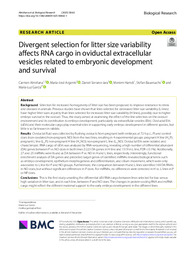Título :
Divergent selection for litter size variability affects RNA cargo in oviductal extracellular vesicles related to embryonic development and survival |
Autor :
ALMIÑANA BRINES, CARMEN 
Argente, María José 
Serrano Jara, Daniel 
Hamdi, Meriem 
Bauersachs, Stefan 
Garcia Pardo, Maria Luz  |
Editor :
BioMed Central |
Departamento:
Departamentos de la UMH::Tecnología Agroalimentaria |
Fecha de publicación:
2025-09 |
URI :
https://hdl.handle.net/11000/37564 |
Resumen :
Abstract
Background Selection for increased homogeneity of litter size has been proposed to improve resistance to stress
and diseases in animals. Previous studies have shown that lines selected for decreased litter size variability (L lines)
have higher litter sizes at parity than lines selected for increased litter size variability (H lines), possibly due to higher
embryo survival in the oviduct. Thus, the study aimed at examining the effect of the line selection on the oviduct
environment and its contribution to embryo development, particularly via extracellular vesicles (EVs). Oviductal EVs
(oEVs) and their molecular cargo play essential roles in supporting early embryo development in different species, but
little is so far known in rabbits.
Results Oviductal fluid was collected by flushing oviducts from pregnant (with embryos at 72 h p.c., P) and control
does (non-ovulated/non-pregnant, NO) from the two lines, resulting in 4 experimental groups: pregnant H line (H_P);
pregnant L line (L_P); non-pregnant H line (H_NO); non-pregnant L line (L_NO). Oviductal EVs were isolated and
characterized. RNA cargo of oEVs was analyzed by RNA-sequencing, revealing a high number of differential abundant
(DA) genes between P vs. NO does in both lines (1223 DA genes in H line and 1519 in L line, FDR<0.1%). Additionally,
27 and 25 miRNAs were found as DA between P vs. NO in H and L lines, respectively. Interestingly, functional
enrichment analysis of DA genes and predicted target genes of identified miRNAs revealed biological terms such
as embryo development, epithelium morphogenesis and differentiation, and cilium movement, which were only
associated to L line for P and NO groups. Furthermore, the comparison between H and L lines identified 169 DA RNAs
in NO does, but without significant differences in P does. For miRNAs, no differences were detected in H vs. L lines in P
or NP does.
Conclusions This is the first study unveiling the differential oEV RNA cargo between lines selected for low versus
high variation in litter size, and in each line, between P and NO does. The changes in protein-coding RNA and miRNA
cargo might reflect the different maternal support to the early embryo development in the different lines
|
Palabras clave/Materias:
Oviduct
Extracellular vesicles
Rabbit
RNA-sequencing
Doe
Pregnant
Embryo
Litter size
Divergent selection |
Área de conocimiento :
CDU: Ciencias aplicadas: Ingeniería, tecnología e industria química. Metalurgia |
Tipo de documento :
info:eu-repo/semantics/article |
Derechos de acceso:
info:eu-repo/semantics/openAccess |
DOI :
https://doi.org/10.1186/s40659-025-00642-1 |
Publicado en:
Biological Research volume 58, Article number: 63 (2025) |
Aparece en las colecciones:
Artículos Tecnología Agroalimentaria
|
 La licencia se describe como: Atribución-NonComercial-NoDerivada 4.0 Internacional.
La licencia se describe como: Atribución-NonComercial-NoDerivada 4.0 Internacional.
.png)
